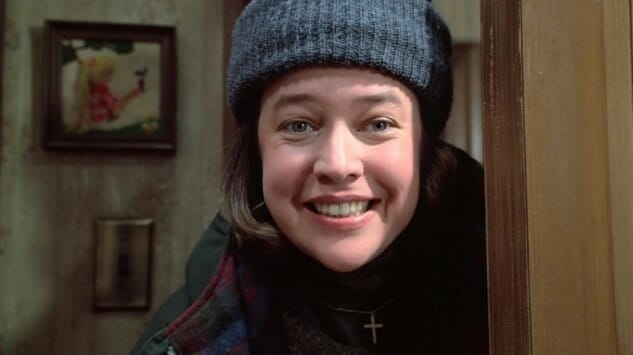The Best Horror Movie of 1990: Misery

This post is part of Paste’s Century of Terror project, a countdown of the 100 best horror films of the last 100 years, culminating on Halloween. You can see the full list in the master document, which will collect each year’s individual film entry as it is posted.
The Year
The year may say 1990, but the films of this year feel very much like an extension of the previous decade, as the slasher genre runs on fumes and increasingly moves into the world of straight-to-video. The rest of the entries are a bit lacking in all-time classics, but this is still a quality lineup with a lot of variation, which is something you won’t be able to say for much of the 1990s. Increasingly, the films here are crossing over with action (Tremors, Darkman) and comedy (Arachnophobia, The Witches), as “true horror” begins to fall a bit out of vogue.
Perhaps most prominent of the non-Misery horror films for 1990 is Jacob’s Ladder, a totally surreal voyage into the subconscious of a Vietnam veteran suffering from intense PTSD, as he attempts to reintegrate into society and finds his days full of disturbing visions of the beyond. Heavily inspired by Ambrose Bierce’s short story “An Occurrence at Owl Creek Bridge” (although it’s a bit of a spoiler to say so), Jacob’s Ladder is a heady and hallucinatory film with David Lynchian overtones, obsessively exploring questions of memory, consciousness and the boundary between life and death. It’s not the kind of film you embark on viewing lightly.
On the opposite side of the spectrum, 1990 is home to plenty of films that are in the “fun” vein, from the superior (and spectacularly gory) sequel Child’s Play 2, to the original battle with the carnivorous, burrowing “graboids” in Tremors, to John Goodman’s hilarious turn as exterminator Delbert McClintock in Arachnophobia. For fans of Creepshow-style horror anthologies, there’s also Tales From the Darkside: The Movie, which borrows one of the stories from Kwaidan and features a charmingly silly framing device with a little boy who has been captured by a witch, telling stories to stall for time like it’s 1001 Nights.
We’re also happy to put in a word for Tom Savini’s occasionally maligned remake of Night of the Living Dead from this year, which very effectively translates George Romero’s 1968 original for a more modern audience, empowering its female heroine to a greater extent while leaving Tony Todd’s Ben relatively intact. The only real knock on the film is the sadly absent gore effects, some of which were intentionally left out to keep the tone similar to the 1968 original, while others were left on the cutting room floor. The loss of these effects steals a bit of thunder from moments that feel like they should be more impactful—especially considering Savini’s role as one of the greatest FX wizards of all time, you’d be forgiven for expecting more of a gory spectacle here. However, if you always just wanted to see Night of the Living Dead in color, with a less annoying Barbara, this is pretty much what you were asking for.
1990 Honorable Mentions: Jacob’s Ladder, Tremors, Night of the Living Dead, Darkman, The Exorcist 3, It, The Witches, Arachnophobia, Tales From the Darkside: The Movie, Child’s Play 2, Nightbreed
-

-

-

-

-

-

-

-

-

-

-

-

-

-

-

-

-

-

-

-

-

-

-

-

-

-

-

-

-

-

-

-

-

-

-

-

-

-

-

-








































